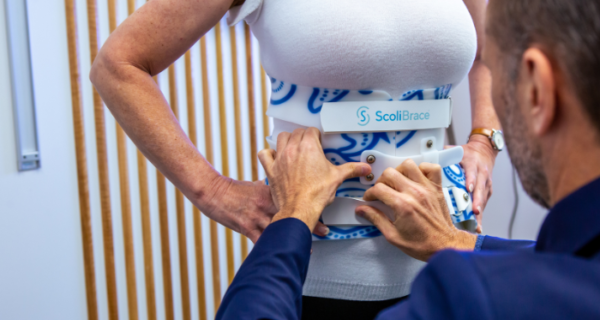Reduction of Scheuermann’s deformity and scoliosis using ScoliBrace and a scoliosis specific rehabilitation program: a case report.
In 2019 Gubbels and colleagues published a case report on the reduction of Scheurmann’s deformity and scoliosis using ScoliBrace and a scoliosis specific rehabilitation program (1).
This study investigated a 26 year old Caucasion male presenting with lower back pain, poor posture and previous diagnosis of Scheurmann’s and adolescent idiopathic scoliosis (AIS).
The patient had:
- difficulty with prolonged standing and sitting
- dissatisfaction with cosmetic appearance
- difficult with leisure activities such as rock climbing.
- a main complaint of continued dissatisfaction with appearance.
- been treated previously with TLSO* brace with the aim of avoiding progression of scoliosis but no plan regarding kyphosis.
*TLSO: thoracolumbar sacral orthosis

How Was the Patient Treated?
The patient was fitted with a ScoliBrace. This is a customised, lightweight, rigid, thoracolumbosacral orthosis (TLSO), made from polypropylene copolymer and a 6mm heel lift. The aim was to improve thoracic kyphosis and sagittal balance, while also addressing lumbar scoliosis and coronal imbalance. More specifically, in the coronal plane (facing from the front or the back) the aim was to correct, using a mirror image of spine and posture. In the transverse plane, when treating the lumbar or thoracolumbar spine, internal lateral bending forces are used to induce coupled spinal motions of rotation to derotate the spine. This is in contrast to his previous brace which used 3 point pressure, the ScoliBrace is designed with a custom asymmetrical module which places the patient into a corrected position. The patient reported that there was no noticeable change in sagittal posture or deformity with old brace.
In summary, the patient treatment included:
- ScoliBrace
- ScoliRoll
- Specific exercises
- 4.5 months of treatment.
What Were the Outcomes for this Patient?
After treatment, on average, the patient reported being mostly pain free, with 2/10 pain on occasion. His Oswestry Disability Index score (ODI) reduced and SRS-22 improved. His hyperkyphosis reduced by 16 degrees (from 79 to 63 degrees) and lumbar scoliosis reduced by 5 degrees (from 30 to 25 degrees).

Authors: Christopjer Gubbels, Paul Oakley, Jeb McAviney, Deed Harrison, Benjamin Brown
Review by: Rosemary Marchese, Physiotherapist, ScoliCare Head of Education & Training
Reference:
- Gubbels, C. M., Oakely, P. A., McAviney, J., Harrison, D. E., & Brown, B. T. (2019). Reduction of Scheuermann’s deformity and scoliosis using ScoliBrace and a scoliosis specific rehabilitation program: a case report. Journal of physical therapy science, 31(2), 159–165. https://doi.org/10.1589/jpts.31.159


